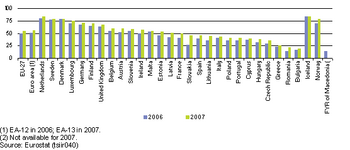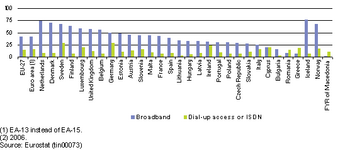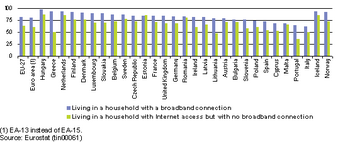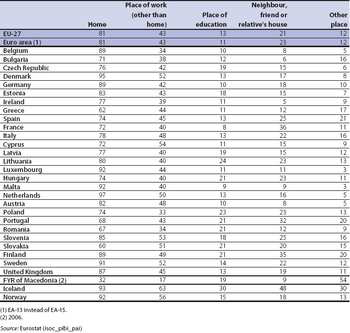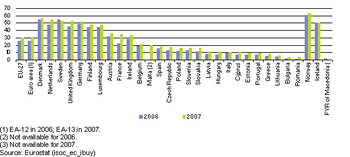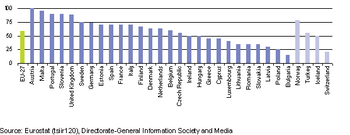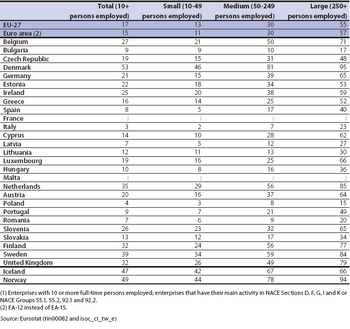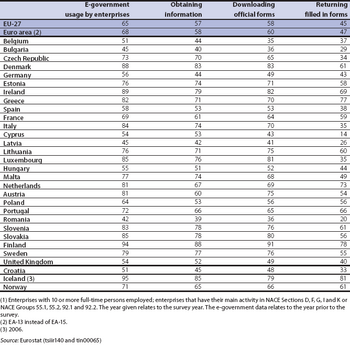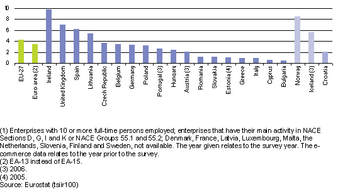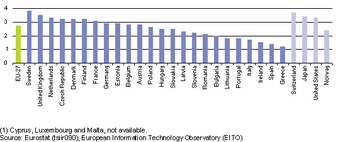Archive:Information society statistics
- Data from September 2008, most recent data: Further Eurostat information, Main tables and Database.
This article presents recent statistical data on many different aspects of the information society in the European Union (EU). Implementing the information society is critical for improving the competitiveness of EU industry and, more generally, to meet the demands of society and the EU economy. Information and communication technology (ICT) affects people's everyday lives in many ways, both at work and in the home, and EU policies in this area range from regulating entire industrial sectors to protecting individual privacy.
Main statistical findings
Households and individuals
During the last decade, ICTs have become widely available to the general public, both in terms of accessibility as well as cost. A boundary was crossed in 2007, when a majority (54 %) of households across the EU-27 had Internet access and this proportion grew still further in 2008 (60 %). The highest proportion (86 %) of households with Internet access in 2008 was recorded in the Netherlands, the lowest (25 %) in Bulgaria. Widespread and affordable broadband access is one of the means of promoting the knowledge-based and informed society. In almost all Member States, broadband was by far the most common form of Internet access (an average of 49 % of all EU-27 households in 2008 compared with 11 % of households that used dial-up access or ISDN access), the exception being Romania.
Two thirds (66 %) of individuals in the EU-27, aged between 16 and 74 years, used a computer in the three months before the 2008 ICT survey. A similar proportion (62 %) of individuals used the Internet. The proportion of individuals using a computer and the Internet in the three months before the 2008 survey rose to between 80 % and 90 % in Sweden, the Netherlands, Denmark, Finland and Luxembourg, but was in a minority in Bulgaria, Greece, Italy, Portugal, Cyprus and particularly in Romania. Almost one third (32 %) of individuals in the EU-27 used the Internet for services related to travel and accommodation in 2008, the spread among Member States being from less than 10 % of individuals in Bulgaria and Romania to between 50 % and 60 % of individuals in Finland, the Netherlands and Luxembourg.
Among Internet users, in other words, those EU-27 individuals using the Internet in the three months before the ICT survey, a large majority (86 %) accessed the Internet from home. By comparison, about one half of this proportion accessed it at work (42 %), around double the proportion accessing from a friend, neighbour or relative’s house (22 %). While 87 % of all individuals aged 16 to 74 used a mobile phone, the proportion of individuals who used a mobile phone for browsing the Internet was only 6 % in EU-27. Finland and Sweden had the highest shares (16 %) for web browsing via a mobile phone.
Of the 62 % of individuals in the EU-27 that used the Internet in the three months before the 2008 ICT survey, seven in every ten accessed the Internet on a daily or almost daily basis. Among Internet users, the proportion of those who used the Internet on a daily basis was highest in Denmark (85 %) and Italy (84 %), the latter despite a relatively low overall rate of Internet use.
Almost two fifths (38 %) of individuals across the EU-27 used the Internet to obtain or share digital content. Looking at selected activities, 28 % of individuals downloaded music or films and 9 % downloaded computer or video games. The proportion of individuals having uploaded self-created content such as text, images, photos, videos or music to any website to be shared was 11 %.
Enterprises
A large minority (40 %) of enterprises in the EU-27 had some form of automated data exchange with an ICT system outside their own enterprise in 2008. For example, about one quarter (27 %) of all enterprises automatically sent payment instructions to financial institutions, similar shares exchanging data with public authorities (25 %) and with customers and/or suppliers (25 %). In motion picture, video, radio and TV activities, a small majority (53 %) of enterprises carried out automated data exchanges. In contrast, only one third (32 %) of hotels, camping and other accommodation enterprises and of construction enterprises carried out automated data exchanges with ICT systems outside their own enterprise in 2008. Sharing information automatically within the same enterprise (for different functions) or outside on the supply chain grew with enterprise size: more than two thirds (70 %) of large enterprises (those employing at least 250 persons) shared within the enterprise and one third (32 %) had automated supply chain management systems in place, which represented more than double the rates for small enterprises (10-49 persons employed).
Around two thirds (68 %) of enterprises made use of e-government services in 2008: a majority using e-government services to obtain information and to download forms (in both cases 61 %), while 50 % of enterprises returned filled in forms. The take-up of e-government services among enterprises was particularly strong (all above 90 % of enterprises) in Finland, Ireland, Denmark and Luxembourg in 2008. Romania was the only Member State to report a minority of enterprises making use of e-government services.
About six in every ten enterprises (64 %) in the EU-27 with over ten persons employed (excluding those in the financial sector) had their own website in 2008. This share increased with enterprise size, as nine out of ten large enterprises had their own website; overall rates were highest in Denmark and Sweden.
Some 16 % of enterprises in the EU-27 received orders on-line during 2007, which was about three fifths of the proportion of enterprises (28 %) that used computer networks to place orders to purchase goods or services. The percentage of enterprises purchasing or selling on-line tends to rise with the size of the enterprise. It may be easier for large enterprises to finance investments for the introduction of e-commerce services. The general pattern across Member States is one where a considerably higher proportion of enterprises have made purchases on-line when compared with those that have received orders on-line (probably reflecting the greater complexity of setting up an on-line selling system compared with making purchases). Almost one third (32 %) of all enterprises in the United Kingdom received orders on-line in 2008, while corresponding shares were also equal to or above one quarter in the Netherlands and Ireland. In contrast, a small majority of enterprises in Ireland, Germany and Sweden made purchases on-line in 2008, with upwards of 40 % of all enterprises in the United Kingdom and the Netherlands also making purchases on-line.
Compared with Japan or the United States, the EU has a relatively low share of ICT expenditure, expressed as a share of GDP; expenditure on information technology represented 2.7 % of GDP in the EU-27 in 2006, compared with 3.4 % in Japan and 3.3 % in the United States.
Data sources and availability
Statisticians are well aware of the challenges posed by rapid technological change in areas related to the Internet and other new applications of ICTs. As such, there has been a considerable degree of evolution in this area, with statistical tools being adapted to satisfy the new demands for data. Statistics within this domain are reassessed on an annual basis in order to meet user needs and reflect the rapid pace of technological change.
This approach is reflected in Eurostat’s Community survey on ICT usage in households and by individuals, and Community survey on ICT usage in enterprises. These annual surveys on ICT use in enterprises and in households/by individuals can be used to benchmark ICT-driven developments, both by following developments for core variables over time, as well as by looking in greater depth at other aspects at a point in time. While the surveys initially concentrated on access and connectivity issues, their scope has subsequently been extended to cover a variety of subjects (including, for example, e-government and e-skills) and socio-economic breakdowns, such as regional diversity, gender specificity, age, educational differences and the individual’s employment situation in the household survey, or a breakdown by size (small, medium, large) in the enterprise survey. The scope of the surveys with respect to different technologies is also adapted so as to cover new product groups and means of delivering communication technologies to end-users (enterprises and households).
Households and individuals
Households are defined as having at least one member in the age group 16 to 74 years old. Household Internet access refers to the percentage that have an Internet access, so that anyone in the household could use the Internet at home, if so desired, simply to send an e-mail. Internet users are defined as all individuals aged 16-74 who had used the Internet in the previous three months. Regular Internet users are individuals who used the Internet, on average, at least once a week in the three months prior to the survey (in general, during the first quarter of 2007).
The technologies most commonly used to access the Internet are divided between broadband and dial-up access. Broadband includes Digital subscriber line (DSL) or xDSL and uses technology that transports data at high speeds. Broadband lines are defined as having a capacity equal to or higher than 144 kbit/s. A dial-up access using a modem can be made over a normal or an ISDN telephone line and, due to its limited bandwidth, it is often referred to as narrowband.
A computer is defined as a personal computer that is run using one of the main operating systems (Macintosh, Linux or Microsoft); hand-held computers or palmtops (PDAs) are also included.
The ordering of goods and services by individuals includes:
- confirmed reservations for accommodation;
- purchasing financial investments;
- participation in lotteries and betting;
- internet auctions;
- information services from the Internet that are directly paid for.
Goods and services that are obtained via the Internet for free are excluded. Orders made by manually written e-mails are also excluded. The indicator shows the percentage of individuals aged 16-74 who have used the Internet, in the 12 months prior to the survey, for ordering goods or services.
Services related to travel and accommodation include using the Internet for ascertaining information or for purchasing goods and services in relation to travel and accommodation, for example, travel tickets, hotels or any other types of accommodation or websites containing information for tourists.
On the Internet people cannot only view information, buy goods or services, or obtain content-related products (for example, downloading music, films or games over the Internet). With the availability of Web 2.0 technology, individuals can also participate in social or professional networks enabling them to generate content and share it with those who have a common interest.
Enterprises
The survey on ICT usage in enterprises covers enterprises that have 10 or more employees. The activity coverage is restricted to those enterprises whose principal activity is within manufacturing, construction, distributive trade, hotels and accommodation, transport and communication, real estate, renting and business activities, motion pictures and video activities, radio and television activities (NACE Sections D, F, G, I and K and Groups 55.1, 55.2, 92.1 and 92.2, respectively). A distinction is made according to the size of enterprises in terms of persons employed into small (10-49 persons employed), medium-sized (50-249) and large enterprises (250 or more persons employed).
Sharing information within the enterprise means sharing information electronically and automatically between different functions of the enterprise under any of the following aspects:
- using one single software application to support the different functions of the enterprise;
- data linking between the software applications that support the different functions of the enterprise;
- using a common database or data warehouse accessed by the software applications that support the different functions of the enterprise, or
- automated data exchange between different software systems.
The sharing of information in this survey was studied in case of receipt of a sales order with at least one of the following functions: management of inventory levels, accounting, production or services management, distribution management; in case of sending of a purchase order with at least one of the following functions: management of inventory levels or accounting.
Sharing information outside the enterprise means sharing information electronically on supply chain management under the following aspects:
- exchanging all types of information with suppliers and/or customers in order to coordinate the availability and delivery of products or services to the final consumer;
- including information on demand forecasts, inventories, production, distribution or product development;
- via computer networks, not only the Internet but also other connections between computers of different enterprises;
- excluding normal e-mail messages manually written.
Indicators relating to interaction with public authorities by enterprises use a concept of public authorities that is as wide as possible, referring to both public services and administration activities. Administration refers to obligations and rights in the country (so-called ‘red tape’), public services referring to non-administrative tasks or competences of government bodies, for example offering a public library’s catalogue on-line. Obtaining information refers to searches for information from public authority websites. Obtaining forms includes downloading official forms for any purpose of use (for example for information or for requesting a service). Returning filled in forms (for example provision of statistical information to public authorities), includes filled in forms sent via Internet only. Treating an administrative procedure completely electronically includes only administrative procedures (for example registration, authorisation request) for which all steps can be treated electronically by means of the Internet without the need for additional paper work, including possible payments, signatures, etc. Submitting a proposal in an electronic tender system (e-procurement) includes the submission of proposals in Internet-based systems (either based on web interfaces or any other architecture).
E-commerce is defined as ordering or selling goods and services over computer mediated networks. On-line purchases or orders received exclude those relating to manually typed e-mail purchases or orders received. The indicator on enterprises having received orders or made purchases on-line covers on-line selling and EDI via Internet or via other computer networks within the year prior to the survey. Only enterprises buying/selling more than 1 % on-line are included.
Data on information technology (IT) expenditure covers expenditure for IT hardware, equipment, software and other services.
Context
Information and communication technologies (ICT) are considered as critical for improving the competitiveness of European industry and, more generally, to meet the demands of society and the economy. ICT affects many aspects of everyday lives, at both work and in the home, and European Union policies in this area range from the regulation of entire industrial sectors to the protection of an individual’s privacy.
The EU policy framework for ICT is the i2010 initiative ’A European Information Society for Growth and Employment’ which seeks to boost efficiency throughout the EU economy by means of the wider use of ICT. The initiative is designed to promote an open and competitive digital economy, research into information and communication technologies, as well as their application to improve social inclusion, public services and the quality of life. Indeed, at the heart of the policy is a desire to ensure that social and geographical differences are overcome, thus creating a fully inclusive digital society. The i2010 initiative has three main priorities:
- creating a 'Single European information space' which promotes an open and competitive internal market for information society and media services;
- stimulating the information society – to strengthen investment in innovation and research in ICT; and
- exploiting the benefits of ICT – to foster inclusion, better public services and quality of life through the use of ICT.
Digital literacy and e-skills are crucial to increasing participation in the information society. The 2007 results of Eurostat’s household survey of information and communication technologies presented here include findings on the levels of computer and Internet skills of the population. According to a Communication from the European Commission on 'e-Skills for the 21st century: fostering competitiveness, growth and jobs’, there is evidence for skills shortages across Europe, with a lack of up to half a million people with advanced networking technology skills, while enterprises report a skills shortfall for ICT practitioners, particularly in ICT strategy, security and new business solutions.
A benchmarking framework for i2010 was approved by the EU Member States and the European Commission in 2006. It defines a comprehensive set of indicators on Internet and broadband take-up and on the use of computers and on-line services by citizens and businesses. In addition, it provides for flexible modules on a specific issue to be defined each year.
Having undergone a mid-term review, an updated i2010 strategy was presented in April 2008, addressing key challenges for the period 2008-2010.
This was followed by a European Commission 'Communication on future networks and the Internet', which outlined the full promise of the social and economic potential of the Internet in the future, based on the premise of high-speed Internet being available to all, and which is internationally open and competitive, secure and safe to use, with transparent and effective governance. These fundamental conditions of accessibility, openness, transparency and security form the basis of the European Commission’s short-term agenda for the Internet of the future, as summarised by six actions:
- the construction of high-speed Internet infrastructures that are open to competition and give consumers real choices;
- promoting access for all to a good-quality Internet connection at an affordable price;
- keeping the Internet open to competition, innovation and consumer choice;
- launching a debate on the design and development of the Internet of the future;
- providing clear guidelines on the implementation of existing rules on data protection and a coherent strategy for a secure Internet of the future;
- taking into account the crucial role that is played by international policy, regulatory dialogue and research co-operation in all these developments.
Broadband technologies are considered to be important when measuring access to and use of the Internet, as they offer users the possibility to rapidly transfer large volumes of data and keep their access line open. The take-up of broadband is considered to be a key indicator within the domain of ICT policy-making. Widespread access to the Internet via broadband is seen as essential for the development of advanced services on the Internet, such as e-business, e-government or e-learning. In the EU, broadband growth has continued in recent years and 42 % of all households have broadband. Digital Subscriber Lines (DSL) remain the main form of delivery for broadband technology, although alternatives, such as the use of cable, satellite, fibre optics and wireless local loops are becoming much more widespread.
Further Eurostat information
Publications
- Science, technology and innovation in Europe
- Science, technology and innovation in Europe – 2007 edition pocketbook
Main tables
- Information society, see:
- Information society statistics
- Policy indicators (t_isoc_pi)
- i2010 Benchmarking indicators (t_isoc_pi_benchmark)
- Information society: Structural Indicators (t_isoc_si)
- Telecommunication services (t_isoc_tc)
- Computers and the Internet in households and enterprises (t_isoc_ci)
- E-skills of individuals and ICT competence in enterprises (t_isoc_sk)
Database
- Information society, see:
- Information society statistics
- Policy indicators (isoc_pi)
- Information society: Structural Indicators (isoc_si)
- Telecommunication services (isoc_tc)
- Computers and the Internet in households and enterprises (isoc_ci)
- E-Commerce by individuals and enterprises (isoc_ec)
- E-skills of individuals and ICT competence in enterprises (isoc_sk)
- Regional Information society statistics (isoc_reg)
Dedicated section
External links
See also
- Information society (Theme introduction)
- Information society statistics at regional level
